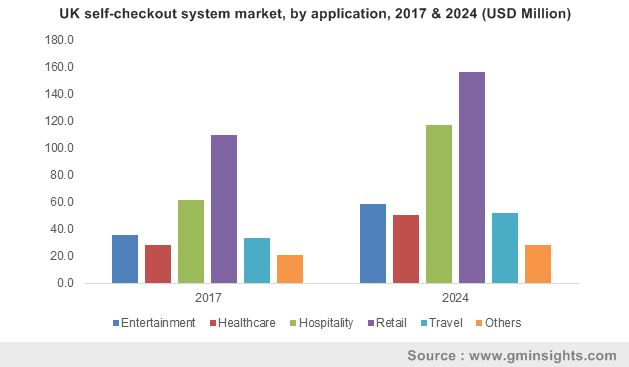Self-checkout systems market to gain extensive returns from the retail sector, high demand for a seamless shopping experience to boost the industry growth
Publisher : Fractovia | Published Date : 2018-03-21Request Sample
With retail outlets massively demanding a hassle-free checkout process, self-checkout systems market has been gaining commendable traction lately. The rising generation of millennials has added further momentum to self-checkout systems industry, given that today’s youth-oriented, tech savvy generation demands perfection with just a mere push of the button. The trend of increasing automation has thus proved to be financially advantageous to numerous businesses. Just recently, a MacDonald’s experiment established that while using a self-service kiosk, customers tended to supersize their orders resulting in 30% more orders – primarily because consumers felt that no one is judging their choices.
UK self-checkout system market size, by application, 2016 & 2024 (USD Million)

One of the pivotal reasons self-checkout systems market has found popularity in the retail sector is on account of the fact that this business space is one of the most evolutionary means of changing the consumer’s perception of shopping. In this regard, companies have been brainstorming different technologies to augment self-checkout system industry. While some manufacturers are producing stationary self-checking counters, others are using scanners on carts that would enable customers to scan items and reduce the wait time at the check-out counter. For instance, Zara implemented self-checkout systems in their stores and introduced an app that lets the buyer make all the shopping choices online, pick up the item in person from the store and pay on the go. The seamless connectivity between online, offline and payment while maintaining anonymity and not being felt judged for one’s fashion choice can potentially revolutionize the world of fast fashion.
Mobile apps are the latest innovation the retail sector is replete with lately, that customers can use to both scan and pay for their purchases. In this present fast-paced era, consumers prefer to experience freedom of choice while making purchases and remain in control of their transactions, thus augmenting self-checkout systems market. Sometimes though, the older generation may find self-checkout systems hard to deal with. In this regard, retail stores offer a variety of options for check out, including both staffed and self-checkout systems, providing a wider scope of development for self-checkout system industry.
Self-checkout systems are known to reduce a significant amount of overhead costs for companies as their deployment reduces labor expenses. For instance, the Information Technology and Innovation Foundation established that a staffed desk at an airport costs the company $3 to check in passengers. But when passengers use electronic terminals, the cost drops to 14 cents. On the whole, the airline industry can apparently save up to $1.6 billion in year with an automated check-in system. It is no surprise therefore, that the lure for cost reduction has been propelling self-checkout systems market.
There is a contention over jobs being lost over the inclusion of such technology, but in reality, employees are not fired over the implementation of self-checkout systems. Rather they are redeployed in places that are more complicated to manage. Thus, many businesses are turning to adopt these systems as it can add a savvier edge to their brand while making it more cost efficient.
The adoption of high-grade technology is a major factor that contributes to the success of self-checkout systems industry. In this regard, self-checkout systems market stands to gain massive benefits from North America and Europe, as the general population here is technologically adept to embrace a system that can simplify their checkout process. In 2016, the National Cash Register of US recorded a deployment of 10000 self service checkout lanes in around 1200 Walmart outlets. Even in UAE and South Africa, tourism and retail have contributed toward stimulating self-checkout systems market. Asia Pacific has also been increasingly implementing technologically advanced shopping options and is expected to register a significant upsurge in self-checkout systems market revenue over 2017-2024. However technological adaptability might even emerge as a restraint for APAC self-checkout system market. For instance, though Japan prides itself on automation and is slowly accepting the self-checkout systems, customers in the country apparently, still prefer a courteous and efficient staff at the check-out counter rather than a self-checkout system.
One of the major obstacles for the expansion of the self-checkout system market has been the increased likelihood of theft or cheating. In this regard, self-checkout systems are being equipped with various technological upgrades like a camera and scales to detect such instances when a customer might be entering the code for onions but might actually be buying avocados. Amazon, a brand that is renowned for taking technology to the next level, introduced the concept of Amazon Go, where customers can lift any item off the shelf and walk out. Numerous cameras and scanners detect each customer’s movement and keep track of what they put on the cart and what they place back on the shelves. Amazon’s technology is a glimpse of the future of self-checkout systems industry which is set to reap vast profits and potentially disrupt the world of retail.